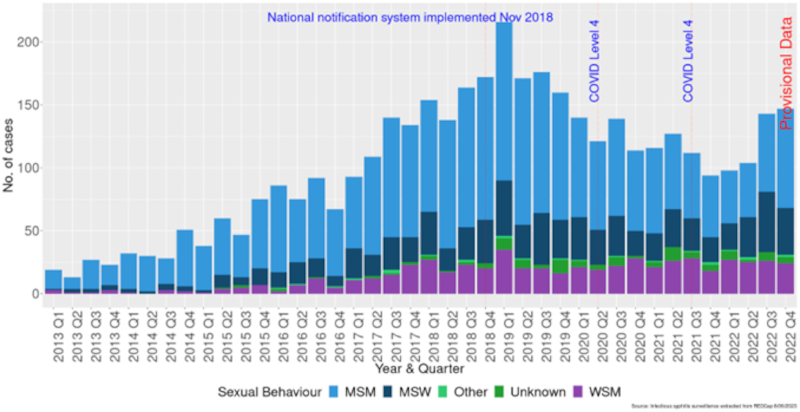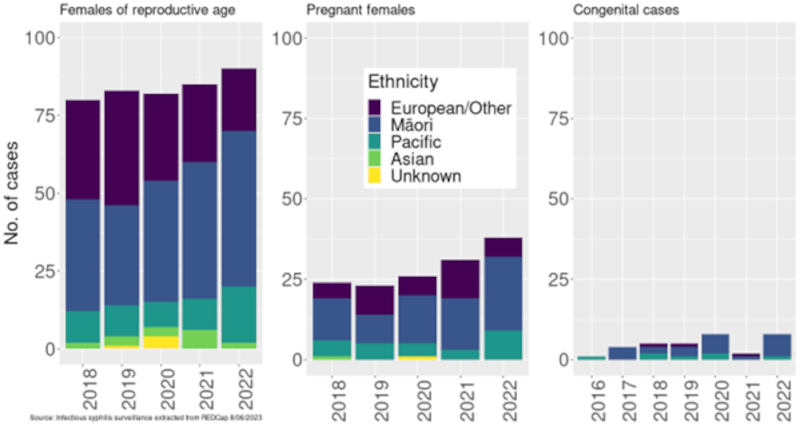Summary
The global resurgence of syphilis is affecting Aotearoa New Zealand (NZ). It is having inequitable impacts amongst Māori and Pacific whānau and for women in pregnancy and their pēpē. The consequences of syphilis in pregnancy include fetal death, prematurity, and critically ill newborns. Prior to 2017, reports of congenital syphilis were rare however in the last 5 years NZ has had over 25 cases. Some hapū māmā continue to miss out on essential antenatal healthcare, including syphilis screening and treatment. Although syphilis screening is performed early in pregnancy, this can miss early infections or syphilis acquired later in pregnancy. Repeat testing for syphilis can be done in the third trimester guided by a risk assessment yet this can be stigmatizing, inequitable and may continue to miss cases. In the northern region of NZ, a new initiative supports all pregnant women to be offered repeat testing for syphilis later in pregnancy as part of the effort to stem the rise in congenital cases.
Congenital syphilis can have tragic consequences for pēpē and their whānau.1 Cases in Aotearoa New Zealand (NZ) are increasing, but with adequate screening and treatment; they can be prevented.
What is congenital syphilis?
Congenital syphilis results from fetal infection with Treponema pallidum transmitted across the placenta following maternal infection. Although infection can occur at any point in pregnancy the likelihood of transmission to the fetus rises as pregnancy advances. Fetal infection is also more likely when the mother is recently infected e.g. in primary, secondary and early latent syphilis but can still occur in women with late latent infections.2
Congenitally infected infants can have a spectrum of clinical problems from no symptoms, to preterm birth; to severely affected with fever, spleen and liver enlargement, rash and low platelets, and occasional fetal death. Bone lesions and neurological infection are particularly common in young infants.3,4 Infants with no initial symptoms may develop problems over years including deafness, eye disease, seizures, and intellectual disability. Treatment in pregnancy with penicillin can prevent fetal and infant disease although newborns may also require penicillin treatment if mothers are not treated inadequately or late in pregnancy.2,5
To give effective treatment for syphilis to women in pregnancy, who are often asymptomatic, we first need to identify cases with universal prenatal serological screening.
Aotearoa NZ epidemiology and Impact
Several countries have reported rising congenital syphilis in the last 5 years, notably in African American populations in United States and Indigenous populations in Australia.6,7. In NZ, case numbers are rising; between 2018 -2020 cases of congenital syphilis were estimated to be over nine per 100,000 live births rising to 14 per 100,000 in 2022, a rate much higher than that reported in Australia.8,9
The US reported a 30% increase in congenital syphilis in 2021 to 79 cases per 100,000 live births, an increase which followed increasing syphilis diagnosed in women of reproductive age.10
In NZ , although an inequitable burden of adult syphilis infections continues to be seen amongst gay and bisexual men (GBM), an increasing number of cases have been in Māori, and more recently Pacific women.9,11 Whilst there was a reduction in cases in the GBM community during 2020-2022, this trend was not evident for women, and a further rebound in syphilis cases amongst GBM in late 2022 may herald similar increases for women and subsequently their infants.
Figure 1: Infectious syphilis notifications by sexual behaviour, number by quarter, 2013-2022
Graph provided by ESR STI Surveillance Team June 2023
Figure 2: Syphilis notifications among women of reproductive age (15-44 years), pregnant women, and congenital syphilis cases, by year (2018-2022)
Graph provided by ESR STI Surveillance Team June 2023
Figure 3: Congenital syphilis notifications by prioritised ethnicity, 2017-2022
Source: ESR STI Surveillance Team June 2023
Across NZ most infectious syphilis cases have been reported from Auckland, Waitemata, Counties Manukau, Waikato and Wellington.9 Lead maternity carers need to be aware of the NZ Sexual Health Society recommendation to re-screen in third trimester, likewise all healthcare professionals need to be alert for possible congenital syphilis cases.2
We have learnt lessons from the pandemic on setting up public health infrastructure that is equitable and accessible. This must continue for other infectious diseases such as syphilis. Addressing poverty, structural racism, mistrust of healthcare and enabling appropriate access to free services needs to continue to be prioritised as underpinning improvements across all health outcomes.
New approaches to screening
The recently published Aotearoa Sexually Transmitted and Bloodborne Infection Strategy 2023-2030 includes elimination of congenital syphilis as a goal.12 Specific initiatives include multi-pronged, cross-agency measures to address structural barriers to antenatal care and increase the Māori and Pacific midwifery workforce. However no specific funding at a national level has been allocated for syphilis prevention and management to date.
Following successful implementation in Waikato, mid Central regions plus a favourable cost-benefit analysis in Counties Manukau in 2020, the entire Northern region introduced routine third trimester screening in May 2023. Although infants with congenital syphilis are born to women who are less likely to have received antenatal care, it is estimated around 1 in 4 congenital syphilis cases had mothers with a normal first trimester screen; repeat screening in the third trimester has the potential to detect and enable treatment of a number of these late infections preventing devastating sequelae.
Figure 4: Missed opportunities for congenital syphilis prevention, 2017- 2022 (further details on categories in Appendix)
Source: ESR STI Surveillance Team June 2023
Given the burden of congenital syphilis does not lie equally across NZ, costs and benefits of additional antenatal screening may differ between regions
Congenital syphilis is a disease we should never see – we have the tools to eliminate syphilis; a sensitive screening test, effective treatment, measures which need to be provided through a trusted healthcare service.
"Any case of congenital syphilis represents a healthcare failure" 13
What is new in this Briefing
- Although syphilis screening is routinely carried out in early pregnancy, this may miss some infections.
Implications for public health policy and practice
- Congenital syphilis is a disease we can and must eliminate.
- Offering third trimester screening, as is now practice in Northern regions, could prevent infections from being missed and help NZ eliminate this disease.
- The wider goal of syphilis prevention and control across the total population also needs to be addressed.
Author details
Dr Emma Best - Paediatric Infectious Diseases specialist, Department of Paediatrics; Child and Youth Health The University of Auckland
Dr Danny de Lore - Paediatrician Rata Hauora Tamariki, Mātai Arotamariki, Te Whatu Ora Lakes
Dr Julia Scott - Public Health and Sexual Health Physician, Health Intelligence Team Institute of Environmental Science and Research Limited (ESR)
Callum Thirkell - Epidemiologist, Registered Paramedic Health Intelligence team Institute of Environmental Science and Research Limited (ESR)
Putu Duff - Senior Advisor, Epidemiology Institute of Environmental Science and Research Limited (ESR)
Dr Sunita Azariah - Sexual Health Specialist and spokesperson for the New Zealand Sexual Health Society
Gary McAuliffe - Clinical Microbiologist and Virologist, Medical Director Pathology and Laboratory Medicine, Te Toka Tumai Te Whatu Ora
Teena Mathew - Sexual Health Physician and Infectious Diseases advanced trainee, Te Toka Tumai e Whatu Ora
Appendix
Information on categories presented in Figure 4
No/ late Antenatal care includes: women who had no antenatal care; women who presented and were tested at the time of delivery or after delivery; and those who had testing less than 4 weeks before they delivered.
No testing includes those who received antenatal care but no syphilis testing was done
New infection in pregnancy – these women had a negative initial/1st trimester or booking screen for syphilis, but had syphilis at the time of delivery so they were infected during pregnancy or incubating infection at the time of the first screen
Inadequate treatment includes the wrong type of penicillin being used, no treatment being given, and the incorrect regime for the stage of disease
Failed treatment includes those who were treated as per guidelines, but it did not prevent congenital syphilis



